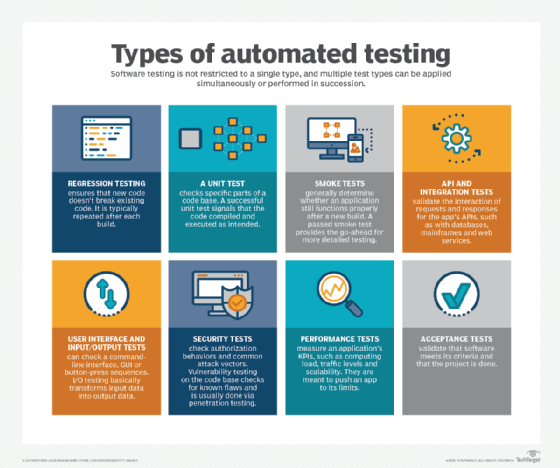
automated testing
What is automated testing?
Automated testing is a software testing technique that automates the process of validating the functionality of software and ensures it meets requirements before being released into production. With automated testing, an organization can run specific software tests at a faster pace without human testers. Automated testing is best suited for large or repetitive test cases.
Automated software testing uses scripted sequences executed by testing tools. Automated testing tools examine the software, report outcomes and compare results with earlier test runs. An automated test script can be created once and then used repeatedly.
An organization can apply automated tests to a broad range of cases, such as unit, application programming interface (API) and regression testing. The main benefit of automated software testing is that it simplifies much of the manual effort into a set of scripts. For example, if unit testing consumes a large percentage of a quality assurance (QA) team's resources, then this process should be evaluated as a candidate for automation.
Automated tests can run repeatedly at any time of day and are an extremely important part of continuous testing, continuous integration (CI) and continuous delivery (CD) software development practices.
How does automated testing work?
The automated testing process generally follows this series of steps:
- Select a testing tool. This depends on the type of testing being done and if the tool in question supports the platform on which the software is being developed.
- Define the scope of automation. This means how much of the software testing is automated.
- Plan, design and develop. This step includes planning the automation strategy and developing test scripts.
- Execute the test. Software is tested using automation scripts. The testing tool should also collect data and provide detailed test reports.
- Maintenance. Automated test scripts are modified and updated as needed with newer versions of a software build.
Tests that are normally automated include the following:
- Acceptance tests.
- API tests.
- Integration tests.
- Regression tests.
- Smoke tests.
- System tests.
- Unit tests.
- User interface (UI) tests.

An organization implements test automation in a framework with common practices, testing tools and standards. Data-driven and keyword-driven test automation frameworks are common, as are frameworks for linear scripting and modular testing.
The linear scripting framework suits small applications, as it enables the use of a test script with little planning but doesn't support reusable scripts. In modular testing frameworks, a software tester creates scripts as small, independent tests to reduce redundancy, but this process typically takes more time to set up.
Data-driven frameworks enable software testers to create scripts that work for multiple data sets and provide wide coverage with fewer tests than modular options. Keyword-driven testing frameworks use table formats to define keywords for each function and execution method; software testers without extensive programming knowledge can work with the keywords to create test scripts. Hybrid-driven frameworks combine two or more practices to take advantage of the benefits of both.
Open source test automation tools and frameworks include Selenium, Robotium and Cypress. Selenium can automate and run test parameters across multiple web browsers and in various programming languages, such as C#, Java and Python. Robotium helps testers write automatic user acceptance, function and system tests for Android devices. Cypress covers end-to-end, integration and unit tests, all within a browser. Cypress enables access to distributed object models in the browser and provides a debugger for further tests.
Benefits of automated testing
Automated testing can boost a QA team's efficiency. Benefits of automating the testing process include the following:
- Better reporting capabilities.
- More frequent tests.
- Enhanced resource efficiency.
- Faster than manual testing and has a faster feedback cycle
- Higher accuracy.
- Improved bug detection.
- Improved return on investment over manual testing.
- Increased coverage.
- Reusable test scripts.
- Scalability.
However, automation isn't ideal for all types of software tests. For example, exploratory testing and visual regression testing are ideally performed manually. But, potentially, repetitive tests, such as integration, performance and unit tests, are ideal for automating.
Software testers manually executing these tests might make mistakes, especially when an application contains thousands of lines of code or numerous repetitive tests are required. Automation helps the QA team avoid these human errors and executes checks in a faster time frame than if they were done in person.
Some test automation tools have reporting capabilities that log each test script to show users the status of every test. A tester can compare the results with other reports to assess how the software operates compared to expectations and requirements.
Overall, automated testing helps staff to avoid manual tests where possible and instead focus on other project priorities. A QA team can reuse automated test scripts to ensure each check executes the same way every time. Additionally, automated testing helps a team quickly find bugs in the early stages of development, which can reduce working hours and project costs.
Misconceptions about automated testing
When considering which testing method to use, organizations should be careful to not fall for these automated testing myths:
- Automated testing provides developers with more free time. In reality, automated testing gives developers more time to focus on larger issues in the development process.
- Automated testing is better than manual testing. Automated and manual testing both have their advantages, and the most comprehensive understanding of an application comes from using both techniques.
- Automated testing discourages human interaction. In reality, automated testing can enhance conversation by providing new channels to communicate through.
- Automated testing is too expensive. Although the initial investment might be costly, over time, the benefits help it pay for itself by reducing the cost of code revisions and manually repeating tests.
- Test scripts can run all build versions. Although automated test scripts are reusable, they still must be modified to work with newer changes for newer builds.
Automated testing best practices
Automated testing is most beneficial when applied to the following:
- Tests that are performed on different hardware or software configurations or platforms.
- Repetitive tests that are used for various builds.
- Tests with multiple data sets.
- Tests that are impossible to perform manually.
- Tests that are too laborious and time-consuming when performed manually.
- Tests for frequently used functionalities.
- Tests that frequently generate human error.
Other best practices include the following:
- Test the software early and frequently.
- Choose the correct automated testing tool.
- Create automated tests that can resist changes in the UI.
- Separate the automated testing efforts.
- Measure metrics, such as the percentage of defects found or the time needed for automation testing in each release cycle.
- Plan the order in which software tests take place.
- Use a tool that automatically schedules testing.
- Set alerts to be notified when a test fails.
Continuous testing
Organizations typically include automated tests in a continuous testing strategy, which conducts code checks at every step in the software development and delivery pipeline. Continuous and automated tests help organizations reduce performance bottlenecks because the pace of work is ongoing rather than start and stop. For example, an organization might release software changes every few hours with automated and continuous testing rather than every few days with a more manual and gated system.
CI/CD pipelines use automated tests and deployment processes that let developers decide to deploy code when it's ready, as opposed to when the system is available to deploy it. CI involves frequent and isolated code changes, as well as immediate testing at each stage of completion before the CI pipeline adds an update to a larger codebase. CD enables executable code updates to go live in staging or production environments; typically, any commit that passes automated integration or other forms of big-picture tests is a valid candidate for release.
Automated testing vs. unit testing
A unit test is a software testing method that can be combined with automated testing. Unit testing examines the smallest part of an application to ensure functionality. Sometimes, this includes scanning every line of code as a separate piece instead of a part of the whole application. While this can help prevent bugs, it limits the assessment of the overall solution.
When unit testing is performed manually, it can be extremely time-consuming and can increase the risk of human errors. Furthermore, manual unit testing removes the collaborative and extensive approach to software development that has been popularized by DevOps culture.
Automated unit tests feature multiple test cases that can be run as each line of code is written. This ability provides developers with an enhanced understanding of the software's overall integrity and the potential value to end users as it is being developed. Furthermore, the previously discussed benefits of automated testing can be applied to the automation of unit tests: The risk of human error reduces drastically, and the time it takes to repeatedly run the tests significantly decreases.
Automated testing vs. manual testing
Manual testing is the exact opposite of automated testing; it involves humans writing and performing all tests on the software. While this extra labor may seem like a disadvantage, it enables developers to benefit from the ability to draw insights from the examination of each step of the process since they are required to go through the software via Structured Query Language and log analysis, testing usage and input combinations, comparing collected results to the projected behavior and recording all results.
In contrast, once the test is written, automated testing removes the focus on all the middle steps and instead concentrates on delivering the end result. This enables tests to be repeatedly performed without the help of developers, thus facilitating continuous testing. In contrast, manual testing requires developers to constantly replicate each step of the process for any test that must be repeated in a specified area.
In addition, automated testing is frequently used after the software has been developed to run longer tests that were avoided during the initial manual testing. When automated, these lengthy tests can run unattended on multiple computers with various configurations.
Learn how to properly evaluate different proprietary and open source automated testing tools.








